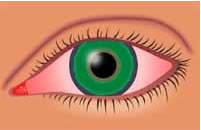Conjunctivitis |
There are three types of conjunctivitis: allergic, bacterial and viral. Conjunctivitis is commonly referred to as "pink eye" since the eye is usually red and swollen.
One of the most common symptoms is discomfort or pain, which may feel like having sand in the eye. Many children have redness of the eye and inner eyelid as well. The child may also have swollen eyelids and be sensitive to bright light. Itchiness and tearing are common with allergic conjunctivitis.
|

|
Allergic conjunctivitis and conjunctivitis caused by an infection can be hard to distinguish. Both have similar symptoms, such as redness, itching and swelling in the eye area. However, when conjunctivitis is caused by allergies, both eyes are usually affected. Viral or bacterial conjunctivitis can affect either a single eye or both eyes. It is important to pinpoint whether someone has conjunctivitis because of allergies or infection since each condition has a different treatment.
Discharge from the eyes may accompany the other symptoms. In bacterial conjunctivitis, the discharge will be somewhat thick and colored white, yellow, or green. Sometimes the discharge will cause the eyelids to stick together when the child awakens in the morning. In viral or allergic conjunctivitis, the discharge may be thinner and may be clear.
All types of infectious conjunctivitis are contagious and can spread from one eye to the other by touching the eyes. A child can first become infected from direct contact with someone who has the infection or something that person has touched, such as a used tissue. The infectious organisms can also spread through coughing and sneezing. In addition, certain viruses spread in the summertime when children swim in contaminated water or share contaminated towels.
Prevention
To prevent infectious conjunctivitis, your child should wash his or her hands often with warm water and soap. Children also should not share eye drops, tissues, eye makeup, washcloths, towels or pillowcases with others.
If your child already has conjunctivitis, he or she should wash their hands after touching the eyes. Your child also should not touch the infected eye and then touch the other eye without first washing his or her hands. Be sure to wash your own hands thoroughly after touching your child's eyes, and throw away items like gauze or cotton balls after they have been used. Wash towels and other linens that your child has used in hot water separately from the rest of the family's laundry to avoid contamination.
If you know your child is prone to allergic conjunctivitis you should keep windows and doors closed on days when the pollen is heavy, and dust and vacuum frequently to limit allergy triggers in the home.
Usually conjunctivitis is a minor eye infection, but it has the possibility to develop into a more serious condition. See your eye care practitioner for a diagnosis before using any eye drops in your medicine cabinet from previous infections or eye conditions.
|
|
|

